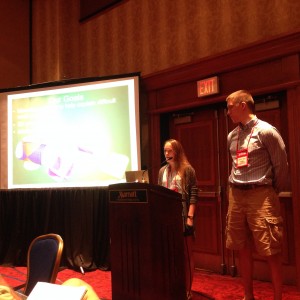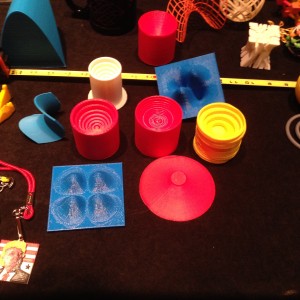 Our summer research project has officially ended. Emily and Ryan have been phenomenal. Together, we’ve designed and 3D printed over 46 math models during the past 9 weeks. Given that our first week was spent working on the math and learning computer programs, we’ve averaged a little over 6 models a week. Phew!
Our summer research project has officially ended. Emily and Ryan have been phenomenal. Together, we’ve designed and 3D printed over 46 math models during the past 9 weeks. Given that our first week was spent working on the math and learning computer programs, we’ve averaged a little over 6 models a week. Phew!


We also 3D printed models that other folks designed, which means we’ve well over 55 different models in total.
We are  all currently at the 2015 MAA MathFest conference in Washington DC. Emily and Ryan will be talking about their work in a student research session, and I will be discussing our work in a session on What can a mathematician do with a 3D printer? organized by the inspirational Laura Taalman and Edward Aboufadel.
all currently at the 2015 MAA MathFest conference in Washington DC. Emily and Ryan will be talking about their work in a student research session, and I will be discussing our work in a session on What can a mathematician do with a 3D printer? organized by the inspirational Laura Taalman and Edward Aboufadel.
 Before I left to come to MathFest, I had W&L photographer Kevin Remington take some stills of just a few of our models in a professional light box. The results are fantastic. Many of these photos appear in Thingiverse, as well as my web page.
Before I left to come to MathFest, I had W&L photographer Kevin Remington take some stills of just a few of our models in a professional light box. The results are fantastic. Many of these photos appear in Thingiverse, as well as my web page.
 These photos show: a few of the quadratics surfaces we designed and printed;
These photos show: a few of the quadratics surfaces we designed and printed;  the strange bowl family; some of our ”sliced” volumes; and the part of a helicoid, the “Bulge Head” solid, and Voronoi Klein Bottle.
the strange bowl family; some of our ”sliced” volumes; and the part of a helicoid, the “Bulge Head” solid, and Voronoi Klein Bottle.


 Our 3D printed math models have arrived in the W&L Mathematics Department ready for the Fall semester. They are in labeled clear plastic containers right over the biz hub in the math work room, so everyone can easily get to them.
Our 3D printed math models have arrived in the W&L Mathematics Department ready for the Fall semester. They are in labeled clear plastic containers right over the biz hub in the math work room, so everyone can easily get to them. 




















